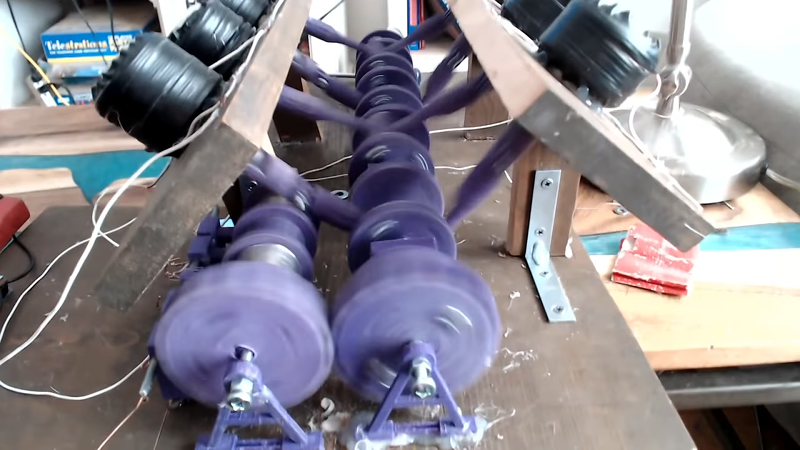Normally when you think of a V8 engine you think of pistons driven by exploding fuel, pushing a crankshaft. [Miller’s Planet’s] version doesn’t use pistons, instead it uses solenoids along with a 3D printed crankshaft. The finished product would make a great science project or classroom demonstration of how a crankshaft converts a reciprocal linear motion into a rotary motion.
There are a lot of 3D printed parts and the links are in the post. A lot of the video (see below) is filmed in the wordless-workshop style with just a few text overlays to explain what is happening. But towards the middle, you’ll hear an explanation of how a solenoid produces force. The real payoff though is at the end, when you get to watch the contraption in motion.
There is a two-part commutator that looks as if it sequences the solenoids. There are some springs involved, but a diagram would have probably made this part clearer. Ignition sequencing wouldn’t be hard to do with an Arduino if you had output circuits that could handle the current of the coils. Most real engines with electronic ignition also have a crankshaft sensor to determine when the shaft makes a full revolution.
We’ve seen some similar builds in the past, and we’ve even seen them done with old hard drives. If you are wondering why you don’t see these actually being used, it is because of their super low efficiency. It takes a lot of input power relative to the output power you can obtain. If you prefer your pistons to be LED-based, you could always build a clock.















I could see some of the bits made from delrin or ptfe to help with the friction. Not nearly as “easy” to do as 3D printering though, and that looks like it took quite a bit of doing.
Holy crap that video is annoying (the music).
Holy crap that comment is annoying (the complaining).
Holy crap that comment is amusing (the turnabout).
Holy Crap, I shit myself (the realisation).
I’d love to hear what it sounds like running. Miller if you see this comment – great project! Thanks for posting all the STL files. If you feel like posting 30 seconds of it running, would love to hear all those solonoids cracking.
I agree. I’d rather have them explain the build process than crappy music.
I would have shortcut the timing with limit switches activated by the ‘piston’ at TDC. Really above and beyond with the use of the timing cam in addition to the home brew solenoids. One could feasibly add a timing belt from this point to demonstrate tuning.
Big question is how much force can the parts withstand before going boom. I have serious doubts it will compare to traditional manufactured parts
Eh? What’s your source of traditional manufactured V8 solenoid example engines?
So funny????
Okay, I’ll be the pedant who clarifies that in an engine fuel is normally burned through combustion, not an explosion. Flame propogation speed is pretty modest, maybe a couple meters per second, but swirling makes it fast enough to get useful power at high RPMs.
I shall join you in this.
Explosions in an ICE are bad. Explosions are one of two things usually known as knock in an engine.
Also, the C in ICE stands for Combustion. Not Explosion.
Is cool. Assuming this is like a MK1 and there will be improvements or just a one off proof of concept thingy? Im surprised there arent more comments in particular to improvements that can be made.
There’s no need to make improvements. If you actually want to turn electricity into movement, electric motors exist and are pretty good. Yup this is just a proof of concept, a toy, or an experiment. Besides being inefficient, I wouldn’t bet too much on it’s reliability, seems likely to break itself soon enough. And that’s why we don’t have V8 electric motors.
Is still cool. I have some antiques of first electric motors. Early 1900s and Most are toy sized. They follow piston pounder design like your V8 proto but usually no more than four solenoids. Mostly steam engine design influence with massive flywheels. Sad is one off. Tky.
Recently this video has been going around, it’ll be cool if this project gets to that stage with machined metal parts!
https://youtu.be/2wfo2QqkXMU